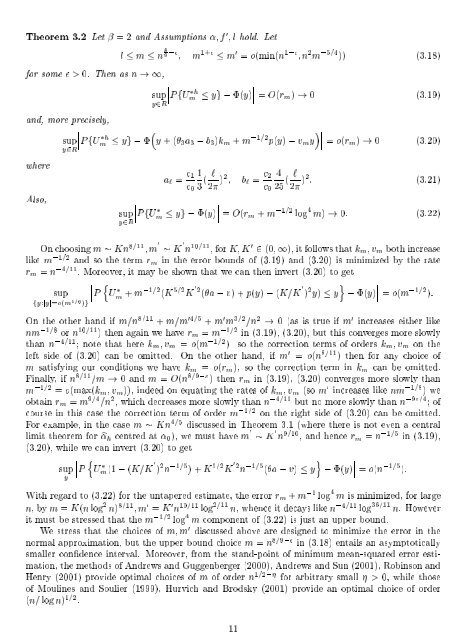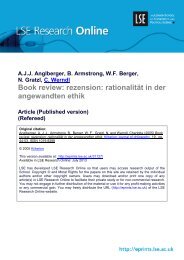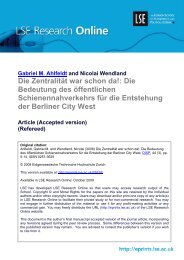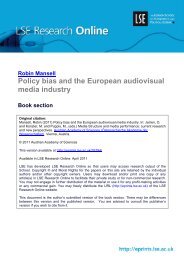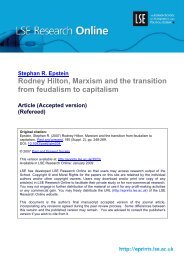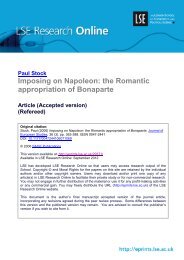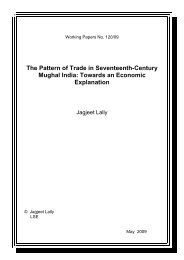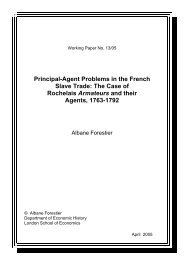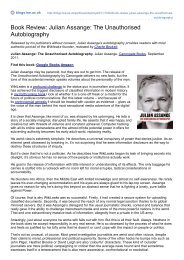Download (535Kb) - LSE Research Online - London School of ...
Download (535Kb) - LSE Research Online - London School of ...
Download (535Kb) - LSE Research Online - London School of ...
Create successful ePaper yourself
Turn your PDF publications into a flip-book with our unique Google optimized e-Paper software.
Theorem 3.2 Let =2and Assumptions f 0 l hold. Let<br />
for some >0. Then as n !1,<br />
and, more precisely,<br />
where<br />
Also,<br />
l m n 8 9 ; m 1+ m 0 = o(min(n 1; n 2 m ;5=4 )) (3.18)<br />
sup P fU<br />
y2R<br />
h<br />
m yg; (y) = O(rm) ! 0 (3.19)<br />
sup P fU<br />
y2R<br />
h<br />
m yg; y +( 3a3 ; b3)km + m ;1=2 p(y) ; vmy = o(rm) ! 0 (3.20)<br />
On choosing m Kn 8=11 m 0<br />
a` = c1<br />
c0<br />
1 `<br />
(<br />
3 2 )2 b` = c2 4 `<br />
(<br />
c0 25 2 )2 : (3.21)<br />
sup P fUm yg; (y) = O(rm + m<br />
y2R<br />
;1=2 log 4 m) ! 0: (3.22)<br />
K 0<br />
n10=11 for K K0 2 (0 1) it follows that kmvm both increase<br />
like m ;1=2 and so the term rm in the error bounds <strong>of</strong> (3.19) and (3.20) is minimized by the rate<br />
rm = n ;4=11 : Moreover, it may beshown that we can then invert (3.20) to get<br />
sup<br />
fy:jyj=o(m 1=6 )g<br />
P<br />
n<br />
Um + m ;1=2 (K 5=2 K 0 0<br />
2<br />
( a ; v)+p(y) ; (K=K ) 2 y) y<br />
o ; (y) = o(m ;1=2 ):<br />
On the other hand if m=n8=11 + m=m04=5 + m0m3=2 =n2 ! 0 (as is true if m0 increases either like<br />
nm ;1=8 or n10=11 ) then again we haverm = m ;1=2 in (3.19), (3.20), but this converges more slowly<br />
than n ;4=11 note that here kmvm = o(m ;1=2 ) so the correction terms <strong>of</strong> orders kmvm on the<br />
left side <strong>of</strong> (3.20) can be omitted. On the other hand, if m0 = o(n8=11 ) then for any choice <strong>of</strong><br />
m satisfying our conditions we have km = o(rm), so the correction term in km can be omitted.<br />
Finally, ifn8=11 =m ! 0 and m = O(n8=9;" )thenrm in (3.19), (3.20) converges more slowly than<br />
m ;1=2 = o(max(kmvm)) indeed on equating the rates <strong>of</strong> kmvm (so m0 increases like nm ;1=8 )we<br />
obtain rm = m9=4 =n2 which decreases more slowly than n ;4=11 but no more slowly than n ;9"=4<strong>of</strong> course in this case the correction term <strong>of</strong> order m ;1=2 on the right side <strong>of</strong> (3.20) can be omitted.<br />
For example, in the case m Kn4=5 discussed in Theorem 3.1 (where there is not even a central<br />
limit theorem for bh centred at 0), we must have m 0<br />
K 0<br />
n9=10 and hence rm = n ;1=5 in (3.19),<br />
(3.20), while we caninvert (3.20) to get<br />
sup<br />
y<br />
P<br />
n<br />
Um(1 ; (K=K 0<br />
) 2 n ;1=5 )+K 5=2 K 0 2 ;1=5<br />
n ( a ; v) y<br />
o ; (y) = o(n ;1=5 ):<br />
With regard to (3.22) for the untapered estimate, the error rm + m ;1 log 4 m is minimized, for large<br />
n, by m = K(n log 2 n) 8=11 m 0 = K 0 n 10=11 log 2=11 n, whence it decays like n ;4=11 log 36=11 n. However<br />
it must be stressed that the m ;1=2 log 4 m component <strong>of</strong>(3.22)isjustanupperbound.<br />
We stress that the choices <strong>of</strong> m m 0 discussed above are designed to minimize the error in the<br />
normal approximation, but the upper bound choice m = n 8=9; in (3.18) entails an asymptotically<br />
smaller con dence interval. Moreover, from the stand-point <strong>of</strong> minimum mean-squared error estimation,<br />
the methods <strong>of</strong> Andrews and Guggenberger (2000), Andrews and Sun (2001), Robinson and<br />
Henry (2001) provide optimal choices <strong>of</strong> m <strong>of</strong> order n 1=2; for arbitrary small > 0, while those<br />
<strong>of</strong> Moulines and Soulier (1999), Hurvich and Brodsky (2001) provide an optimal choice <strong>of</strong> order<br />
(n= log n) 1=2 .<br />
11


